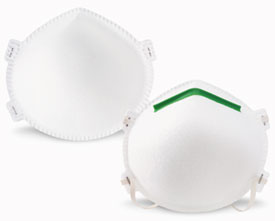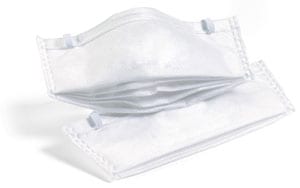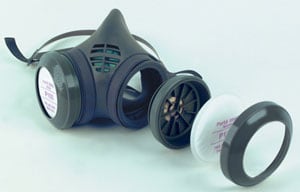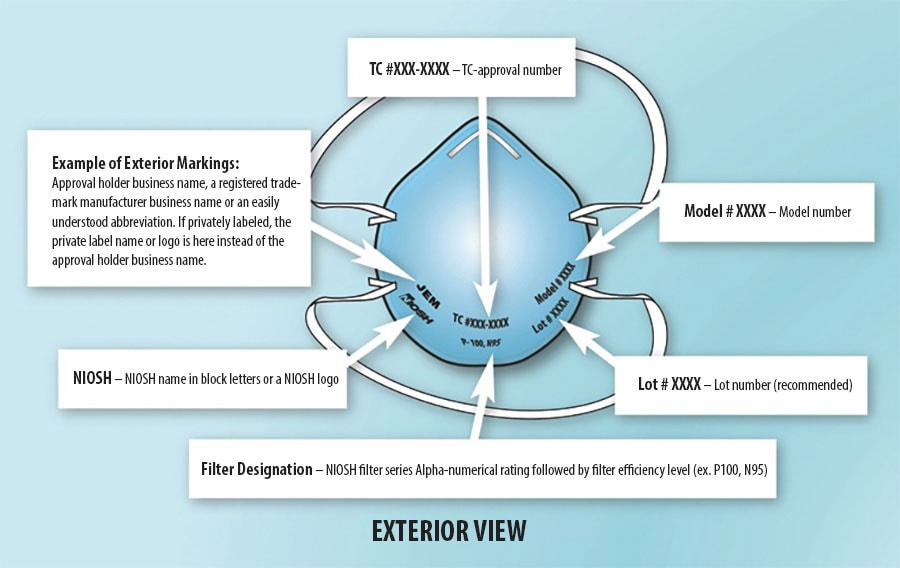You may have been told by your employer that you need to wear a respirator to perform some of your workplace tasks. In fact, approximately 5 percent of all U.S. workers in about 20% of all work establishments wear respirators at least some of the time while performing their job functions. These workers are employed at approximately 1.3 million establishments nationwide. Approximately 900,000 of these establishments have been determined to be “very small,” i.e., having fewer than 20 employees.
A respirator is a personal protective device that is worn on the face, covers at least the nose and mouth, and is used to reduce the wearer’s risk of inhaling hazardous airborne particles (including dust particles and infectious agents), gases or vapors. Respirators should only be used as a "last line of defense" in the Hierarchy of Controls when engineering and administrative controls are not feasible or are being put in place.
Respirators protect the user in two basic ways. The first type of respirator removes contaminants from the air, and are called air-purifying respirators (APR). APRs include particulate respirators, which filter out airborne particles, and “gas masks,” which filter out chemicals and gasses. Other respirators protect by supplying clean respirable air from another source. Air-supplying Respirators (ASR) comprise this category of respirators. They include airline respirators, which use compressed air from a remote source; and self-contained breathing apparatus (SCBA), which include their own air supply.
The classification of particulate respirators can be further subdivided into three categories:
- Particulate filtering facepiece respirators – Sometimes referred to as disposable respirators because the entire respirator is discarded when it becomes unsuitable for further use due to considerations of hygiene, excessive resistance, or physical damage. These are also commonly referred to as “N95s.”
- Elastomeric respirators –Sometimes referred to as reusable respirators because the facepiece is cleaned and reused but the filter cartridges are discarded and replaced when they become unsuitable for further use.
- Powered air-purifying respirators (PAPRs) – A battery-powered blower moves the air flow through the filters.
What is a NIOSH-Approved N95 Respirator?
Even though you see N95 on the package, it still may not be the right kind of respirator, or one that meets NIOSH approval requirements.
You may have heard that a NIOSH-approved N95 respirator is recommended for your respiratory-protection needs. This is one of the most commonly used respirators. Again, even though you see N95 on the package, it still may not be the right kind of respirator, or one that meets NIOSH approval requirements.
"N95 respirator" is a term used to describe the class of respirators which use N95 filters to remove particles from the air that is breathed through them. The NIOSH respirator approval regulation defines the term N95 to refer to a filter class that removes at least 95% of airborne particles during “worse case” testing using a “most-penetrating” sized particle during NIOSH testing. Filters meeting the criteria are given a 95 rating. Many filtering facepiece respirators have an N95 class filter and those meeting this filtration performance are often referred to simply as N95 respirators.
How are NIOSH-Approved Particulate Filtering Respirators Classified?
Your employer may have told you that respiratory protection is needed because of inhalation hazards from airborne particles, which may include infectious agents. NIOSH-approved particulate filtering respirators can be used to protect you from these hazards. It is important for you to understand how NIOSH-approved respirators that use filters to remove particles from the air that is breathed through them are classified.
There are ten classes of NIOSH-approved particulate filtering respirators available at this time. 95% is the minimal level of filtration approved by NIOSH. The N, R and P designations refer to the filter's oil resistance as described in the table below.
|
Filter Class
|
Description
|
| N95, N99, N100 | Filters at least 95%, 99%, 99.97% of airborne particles. Not resistant to oil. |
| R95, R99, R100 | Filters at least 95%, 99%, 99.97% of airborne particles. Somewhat resistant to oil. |
| P95, P99, P100 | Filters at least 95%, 99%, 99.97% of airborne particles. Strongly resistant to oil. |
| HE (High Efficiency Particulate Air) | Filters at least 99.97% of airborne particles. For use on PAPRs only. PAPRs use only HE filters. |
The two most common configurations for particle filtering respirators are filtering facepieces and elastomerics. As the name implies a filtering facepiece respirator is one in which the facepiece is comprised of the filter material. Two examples of filtering facepiece respirators are the cup style (see Figure 1), and the flat fold type (see Figure 2). Elastomeric respirators are comprised of a molded facepiece to which replaceable filtering cartridges are attached (see Figure 3).
Figure 1 - Filtering facepiece respirator, preformed type.

Figure 2 - Filtering facepiece respirator, flat fold type.

Figure 3 - Elastomeric respirator.

Markings and Approval Labels
When it comes to knowing if your respirator has a NIOSH approval, the label is important.
Identifying approved respirators is not too difficult if you know what to look for. All NIOSH-approved respirators have an approval number. With few exceptions the NIOSH approval number is not on the respirator itself, but on a separate NIOSH approval label which is found on, or within the packaging. An example of this type of NIOSH label is shown in Figure 1. The approval number is shown in red, and the protection is shown in blue, N95 on this example. The NIOSH approval number and approval label are your keys to identifying NIOSH-approved respirators. Respirator approvals are occasionally revoked. If this should happen, NIOSH sends a User Notice to all NIOSH NPPTL listserv subscribers and removes the approval number from NIOSH listings of approved respirators. However, inventories of the revoked respirators still may be available for purchase or consumers may have them on hand from an earlier purchase. You may readily verify that respirator approvals are valid by checking the information links on the NIOSH Trusted-Source page, or in the NIOSH Certified Equipment List (CEL). Users are encouraged to self-subscribe to the NIOSH listserv service to receive User Notice email notifications concerning the status of respirator approvals and other relevant information.
Both an approval label and user instructions are both supplied with all NIOSH-approved respirators. These documents, a single copy of which may accompany either a large or small package of respirators, should not be discarded before all of the respirators are used or discarded. In addition to the approval number, the NIOSH approval label contains contact information for the respirator manufacturer/supplier, cautions, and limitations for use, and directions for proper use. It is very important to read and follow all of the manufacturer’s instructions for the particular respirator that you are using.
With regard to the approval number not appearing on the respirator, one important exception to note would be some filtering facepiece respirators. Figure 2 below shows typical markings on approved filtering facepiece respirators. The markings shown in red are present on all NIOSH-approved filtering facepiece respirators, although they may appear either on the face, on the exhalation valve (if one exists) or on the head straps. The markings shown in black may or may not be on the respirator at all. The model or part number marked on the respirator will also appear on the approval label.
Figure 1 - Example of NIOSH approval label.

Figure 2 - Example of typical markings on approved filtering facepiece respirators.

Many Different Manufacturers Provide a Large Variety of Respirator Models
Filtering Facepiece Respirators approved by NIOSH as N95s are often recommended when individuals may be exposed to small particle aerosols. When an N95 respirator is required as the minimum level of protection, there are also six other grades of products that will satisfy this minimum requirement. R-type or P-type series filters may be employed in situations where N95 respirators are recommended, although N-types may not be substituted where R-type or P-type series are required. Each series has three potential levels of efficiency (95, 99, and 100). The following links will take you to lists of filtering facepiece respirators approved by NIOSH. Supplier information is also available from these lists.
Other NIOSH-Approved Respirators with Similar Protection
As an alternative to filtering facepiece respirators, respirators using replaceable filters with a washable (able to be cleaned and disinfected), or even a disposable elastomeric (rubber-like) facepiece are also approved with the same protection types. The facepieces available are either half-mask, fitting under the chin and only covering the nose and mouth, or full facepiece, a type having a clear lens which covers the eyes as well as the nose and mouth. The links that follow provide lists of approved respirators employing elastomeric facepieces with the same protection categories as filtering facepiece respirators approved by NIOSH. Following the links on the pages will provide more information about the NIOSH approval and the manufacturer of the respirator.
Note: When using the links listed below use your browser's "Back to..." button to return to this page.
Halfmask Respirators
- N95 Elastomeric Halfmask Respirators
- N99 Elastomeric Halfmask Respirators
- N100 Elastomeric Halfmask Respirators
Full Facepiece Respirators
Powered Air-Purifying Respirator (PAPR)
The final category of particle filtering respirators that may be considered as alternatives to N95 filtering facepiece respirators is known as the Powered Air-Purifying Respirator (PAPR). This type of respirator uses a battery-powered blower to force air through a particle filter for the wearer to breathe. They are capable of filtering particles from the air at efficiencies suitable to be substituted in situations where an N95 type filter has been recommended. The protection category for particle filtering PAPRs is designated as HEPA, which stands for High-Efficiency Particulate Air filter. The links that follow provide lists of approved PAPRs employing various types of elastomeric facepieces or helmet/hood-type head coverings. Following the links on the pages will provide more information about the NIOSH approval and the manufacturer of the respirator.
- HEPA PAPR with Full Facepiece
- HEPA PAPR with Halfmask Facepiece
- HEPA PAPR with Helmet
- HEPA PAPR with Hood
- HEPA PAPR with Hood and Helmet




